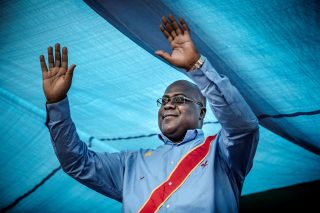Nicolas Kazadi, Finance Minister for the Democratic Republic of Congo (DRC), recently outlined the Congolese government’s ambitious plans to turn the country into an African industrial hub with the launch of a far-reaching reform agenda. The roadmap Kazadi laid out is a first step towards concretizing the vision that DRC President Félix Tshisekedi evoked in a late June speech, wherein he promised to embark on “a new fight against poverty and social injustice”.
Indeed, for all its vast mineral wealth—Congo is one of the richest countries in the world in terms of important resources like cobalt and diamonds—the DRC remains one of the poorest countries on the planet. The nation has, nevertheless, made progress since Tshisekedi was elected three years ago, earning praise from the chief of the IMF. It will now fall to Tshisekedi, Kazadi and the rest of the Congolese government to use the DRC’s ample resources to diversify its economy and bolster its industrial capabilities in a variety of sectors. It’s a familiar scenario across much of Africa, too, with many countries targeting greater long-term growth and more stable revenues through a like-minded approach.
DRC seeks to build on encouraging start to reforms
At the time of his election in 2019 – which marked the first peaceful transition of power in the DRC since its independence six decades ago – Tshisekedi pledged to reverse his country’s ailing fortunes and address issues, such as corruption, which were hamstringing the economy. Since taking office, Tshisekedi has taken steps to set the country on a steadier economic path, including granting more independence to the country’s central bank, optimizing the efficiency of the taxation system and reshuffling the boards of important institutions such as the Central Bank and the state mining company. Those bold moves have sparked interest among overseas investors, giving an ensuing boost to the Congolese economy. Kinshasa recorded growth of 6.2 per cent in 2021 (up from 1.7 per cent the year prior), while the national deficit dropped from 2.2 per cent of GDP in 2020 to 0.5 per cent last year and a surplus is even expected in 2022.
At almost double the regional average, those figures are very encouraging, especially when set against the backdrop of crises which are crippling economies around the world. Tshisekedi and Kazadi are aiming even higher in terms of growth, however—unsurprisingly, given the sheer scale of the country’s mineral resources. Indeed, the DRC is widely regarded as one of the wealthiest countries on Earth in terms of its natural resources. Home to more cobalt reserves than the next 10 countries combined, it’s also home to 60 per cent of the global coltan supplies and is the fourth largest copper producer. Cumulatively, the DRC’s mineral resources are estimated to be worth a staggering $24 trillion.

The fact that many of those resources are integral to the manufacturing of batteries – at a time when the electric vehicle (EV) industry is on the cusp of explosion – means that Kinshasa is well-placed to become a modern African success story, leveraging its resources in a similar way to how Saudi Arabia parlayed oil wealth into a place among high-income countries. What’s more, the Congolese government has expressed its determination to move past simply exporting these valuable raw commodities, keen to trade as well in manufactured goods, including by producing EV batteries and battery components locally.
A continent-wide conundrum
The economic diversification targeted by the DRC is something that countries across Africa also aspire to. According to the United Nations Conference on Trade and Development (UNCTAD), 45 of the continent’s 54 nations are still too heavily reliant on exporting commodities for their economic stability. The volatility of commodity prices (especially during times of global pandemics and international conflicts) can create macroeconomic instability, which is why diversifying into new sectors is so crucial to long-term fiscal security.
Nigeria has made some good moves in this regard. Aware that it is overly dependent on an oil industry that has been stagnating for some time already, the country’s Central Bank has instigated several positive initiatives. The RT 200 FX Program aims to raise $200 billion from non-oil exports in the next three to five years, while the Anchor Borrowers’ Programme (ABP) has allowed the country to turn itself from a rice importing nation into an exporting one. Meanwhile, the establishment of the digital currency eNaira is also expected to help Nigeria tap into the burgeoning fintech scene in Africa. That’s something that Mauritius has already done well; in recent years, the small island nation has moved away from its historically agricultural background into IT and financial services, with 40 per cent of its GDP and 56 per cent of its employment opportunities now provided by SMEs.
Taking inspiration
These success stories provide encouraging food for thought for policymakers across Africa seeking to parlay natural resources into national wealth while also diversifying the economy, including the leading decision-makers in Kinshasa. Naturally, the challenge of lifting countries like the DRC—where 73 per cent of the 95 million-strong population were subsisting on less than $1.90 per day as of 2018—out of poverty will require dedication, hard work and significant investment.
However, there are plenty of reasons to be positive on that last front. The IMF recently approved $203 million to support the DRC’s balance-of-payment requirements, which comes on top of a $250 million grant windfall from the World Bank last year. Meanwhile, the private sector is stepping up on a wider scale, too. 2021 saw $200 billion invested into African fintech companies, which was a 200 per cent rise from the previous year. Indeed, overall venture capital growth rose 215 per cent, the highest increase anywhere in the world. Suppose African nations like the DRC can leverage abundant natural resources and outside investment and funnel those funds into diversified sectors. In that case, there’s no reason they can’t ramp up their production and processing capacities, securing long-term prosperity in the bargain.








